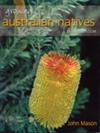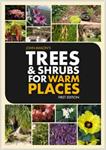Water Wise Australian Plants
AUSTRALIAN PLANTS FOR WATER WISE GARDENS
As drought and the heat of summer sets in, many gardens begin to look limp and tired. Lawns burn, plants wilt, flowers fade and leaves drop. Every summer we waste hours of time and thousands of litres of water trying to keep our gardens looking fresh. Despite living in the driest continent on Earth, most Australian gardeners still use tender exotic plants which cannot cope with long periods of hot, dry weather.
Australian native plants which are naturally adapted to dry conditions are an ideal choice – once established, many require minimal watering in summer, even surviving drought conditions. Newer ornamental cultivars of native plants are available in nurseries, making it very easy to choose hardy and attractive native plants for dry gardens.
Gardening in dry conditions
Dryness can be thought of in terms of:
- Air dryness (low humidity), commonly experienced in inland Australia and the far south of the continent (away from coastal and mountain areas).
- Soil dryness, either as a result of low rainfall or the soil’s inability to retain water. Poor water retention is common in sandy soils, on sloping ground, compacted soils, soils subject to surface crusting, and in raised garden beds or mounds.
Whatever the reason, there are many plants that can be grown in drier areas. The tolerance of different plants for dry conditions varies greatly:
- Some plants tolerate dry soil but not dry air.
- Some plants tolerate dry soil, and low humidity.
- Some plants tolerate periods of dry conditions but not all the time, ie. seasonal dry periods.
- Many plants prefer dry soil when growth slows down in cooler weather. Moist soil during cool, slow-growth periods can lead to root rot problems and lower the plant’s ability to withstand pest and disease attack.
- Some plants need moist soil to establish, but can then withstand dry conditions.
Overcoming dryness
Problem
|
Cause
|
Solution
|
|
Too much runoff
|
Sloping ground
|
Create terraces
|
|
Build a rockery and create pockets of organic- rich soil
|
|
Mulch surfaces well
|
|
Soil doesn’t hold water
|
Sandy soil
|
Add well rotted compost and manures
|
|
Use mulch
|
|
Add water retaining crystals
|
|
Soil is very wet then dry
|
Clay soil
|
Add sand and organic material
|
|
Use mulch
|
|
Add gypsum
|
|
Soil is dusty and water doesn’t penetrate the surface
|
Soil has become water repellent
|
Add soil wetting agents
|
|
Add well rotted organic materials
|
|
Use mulch
|
|
Soil requires frequent watering
|
Poor watering techniques
|
Install a drip irrigation system
|
|
Deep watering using a soaker hose or sprinkler once/week instead of frequent hand watering.
|
Dry Pots
Potting mixes often dry out rapidly and need frequent watering, particularly in hot, windy conditions. Soils in terracotta pots are especially prone to drying out quickly. If you want to overcome this problem, use potting mixes which are specifically designed for terracotta pots – water retaining granules/crystals and peat are often added to the mix to improve water retention.
Potting mix that is allowed to dry out is often difficult to re-wet evenly. Wetting agents can be applied to help improve water penetration (infiltration into and throughout the potting mix, helping to ensure the entire mass of potting mix is moist).
Drip irrigation systems with individual drippers for each pot are also very useful in keeping the soil moist.
Growing Dry-Loving Plants in Moist Soils
If you want to grow a dry-loving plant but the soil is too moist:
- Improve soil drainage - add sand and install drains
- Build a raised bed
- Grow it in a pot
- Some natives (eg. Grevilleas, Banksias, Corymbias, Geraldton Waxes) can be obtained as grafted plants, grown on hardy rootstocks that will cope with moister soil conditions.
The following lists provide just a few of the possibilities. There is a huge range of natives suited to dry conditions. Ask at your local nursery for natives suited to your locality.
TREES
Agonis flexuosa (Willow Myrtle)– A medium sized tree to 14 m, with weeping branches and narrow leaves. Tolerates medium dry conditions for cool temperate districts. Some success is achieved in Brisbane localities. Dwarf and variegated cultivars are available. Now available is an attractive new cultivar ‘After Dark’ with blackish leaves.
Allocasuarina cristata (Belah) – Fast-growing casuarina to 12 m. Very drought tolerant, also tolerates wet soils.
Allocasuarina descaisneana (Desert Oak) – Very drought tolerant casuarina to 15 m. Pendulous habit.
Allocasuarina stricta (Drooping She-oak) – Hardy casuarina to 10 m. Tolerates dry, wet and coastal conditions.
Allocasuarina torulosa (Forest Oak) – Small to medium casuarina to 10 m. Rough, corky bark and reddish fine leaves. Tolerates dry, wet and cool conditions.
Alstonia constricta (Quinine Bush) – Medium tree to 12 m with milky sap and small yellow flowers in spring. Good shade tree for drier districts.
Angophora floribunda (Rough-barked Apple) – Medium to large tree to 20 m. Mature trees have twisted, gnarled trunk and branches. Needs well drained to dry soil.
Brachychiton populneus (Kurrajong) – Hardy tree with dense rounded crown to 20 m. Tolerates very dry soil and cold conditions.
Buckinghamia celsissima (Ivory Curl Flower) – Tree up to 12 m but rarely over 6 m in cultivation if grown without irrigation. White ivory flowers are produced in summer.
Callitris endlicheri (Black Cypress Pine) – Narrow conifer-like tree to 10 m. Tolerates dry, arid conditions.
Callitris preissii – Large shrub or small tree. More variable and open habit compared to other Callitris. Tolerates very dry, arid conditions.
Capparis mitchellii (Native Orange) – Small rounded tree to 5 m with white flowers and edible fruit. Untidy when young but very handsome and mature. Good for dry areas.
Cassia brewsteri – Medium tree to 8 m with semi-deciduous habit. Pendulous yellow-red flowers in spring. Very hardy to dry sites.
Denhamia oleaster – Good inland dry tree to 8 m with spreading and pendulous branches.
Eucalyptus (syn. Corymbia) – Many species tolerate dry conditions. Some of the more attractive ornamental species include:
E. caesia ‘Silver Princess’ – Small pendulous tree to 8 m with silver stems and large pendant pink flowers.
E. forrestiana – Small bushy tree with large red bell-shaped buds and red flowers.
E. leucoxylon rosea – Small to medium tree to 15 m with red flowers.
E. sideroxylon rosea – Medium tree to 15 m with dark furrowed bark, grey leaves and red flowers.
E. torquata – Small spreading tree to 8 m with profuse pink flowers.
Geijera parviflora (Wilga) – small spreading tree to 12 m with linear leaves and small cream flowers. Well suited to dry areas.
Melia azederach (White Cedar) – Spreading deciduous small to medium-large tree. Purple and white flowers. Tolerates medium-dry conditions.
MEDIUM – TALL SHRUBS
Acacia – Very large diverse genera with tall trees to small ground hugging plants. All are very tolerant of very dry conditions.
Banksia ashbyi – Rounded shrub to 3 m high with long toothed leaves and large orange spikes. Needs very well drained soil at all times.
Banksia ericifolia – Rounded shrub to 5 m high with bright green linear leaves and long cylindrical orange flowers. Hardy in a wide range of conditions including dry soil.
Banksia marginata – Variable shrubs to 5 m with yellow cylindrical flower spikes. Very hardy in a wide range of conditions including dry soil.
Banksia ornata – Rounded shrub to 2 m with 10 cm tall yellow-brown flower cone. Well adapted to dry sites.
Callistemon viminalis – Variable shrub to small tree with many highly attractive cultivars. Bright red-bottlebrush type flowers in early summer – autumn, that make excellent cutflowers. Adaptable as to soils, but some forms may be susceptible to frost damage.
Calothamnus quadrifidus – Shrub to 2 m with narrow pine-like leaves and red bottlebrush-type flowers. Tolerates medium-dry conditions.
Chamelaucium uncinatum (Geraldton Wax) – Highly attractive flowering plant in variable colours. Well suited to dry soils and low air humidity.
Grevillea ‘Pink Pearl’ - Tolerates very dry soil.
Grevillea ‘Poorinda’ hybrids – Range of small to tall shrubs and groundcovers, most of which tolerate medium-dry conditions.
Grevillea rosmarinifolia – Variable shrub to 2 m with narrow leaves and red spider flowers. Several forms available including dwarf shrubs and groundcovers. Very hardy in dry and cold conditions.
Hakea bucculenta – An erect, very ornamental shrub to 4 m tall by 2-3 m wide, with linear leaves to 15 cm or more. Spikes of attractive reddish-coloured flowers are borne on old wood in winter.
Hakea multilineata – A very ornamental, erect shrub to 5 m tall and 3 m wide. It often requires staking when grown in an open position. It has narrow, oblong leaves to 20 cm, and attractive spikes to 20 cm long of red, pink or white flowers in winter – spring. Hardy once established in a sunny, well drained position.
Hakea petiolaris – An erect shrub to 5 m tall x 3 m wide, with grey-green elliptical leaves to 10 cm long, and globe-shaped heads of dull red flowers with brighter yellowish-coloured styles in autumn – winter.
Jacksonia scoparia - Medium to tall shrub to 4 m with leafless pendulous branches and yellow and red pea flowers. Very hardy in dry soil.
Lambertia formosa (Mountain Devil) – Erect bush plant to 2 m with red flowers. Will tolerate a wide range of dry soils.
Leptospermum – Hardy and variable genera with white showy flowers in spring-summer.
Melaleuca armillaris – Tall spreading shrub to 5 m with white bottlebrush flowers. Tolerates very dry soil.
Melaleuca decussata – Medium shrub to 2 m with small mauve bottlebrush flowers. Tolerates very dry soil.
Melaleuca hypericifolia – Medium to tall shrub to 5 m with rusty red bottlebrush-type flowers. Tolerates very dry soil.
Petrophile (conesticks) – Medium sized shrubs that require excellent drainage and low humidity. Species come in a range of flower colours.
Xanthorrhoea (Grass tree) – These icons of the bush are excellent is a dry garden without any supplementary irrigation. Can grow up to 6 m but usually only 2-3 m tall.
LOW SHRUBS
Acacia – Variable group of natives with yellow puff-ball flowers, mostly scented. Tolerant of very dry conditions.
Anigozanthus – Kangaroo paws are well known to be perfect for dry and low humidity areas.
Atriplex nummularia (Saltbush) – Erect shrub to 1.5 m with grey leaves. Very hardy in hot, arid conditions.
Calytrix tetragona – Variable shrub to 1 m with bright green narrow leaves and white or pink star flowers. Tolerates medium-dry conditions.
Cassia nemophila – Rounded shrub to 2 m with yellow flowers. Tolerates warm and very dry conditions.
Dryandra praemorsa – An attractive bushy, shrub to 2 m tall x 1 m wide, with showy, tooth-leaved foliage, and attractive heads of bright yellow flowers in spring. Needs a semi-shaded, well drained position. Probably the best Dryandra species for the eastern states.
Eremophila maculata (Emu Bush) – Variable shrub to 2 m with yellow, pink or red spotted flowers. Very hardy in dry conditions.
Eriostemon myoporoides – Rounded shrub to 1-2 m with white star flowers. Hardy in a range of conditions including medium dry soil.
Grevillea juniperina – Rounded shrub to about 2 m with greenish-yellow or red flowers in early winter and spring. Needs a sunny well drained site.
Grevillea lavandulacea – Small native with variable forms mostly with white of pink flowers. Needs well drained location.
Leucophyta brownii – Small spreading shrub with silvery branches and leaves.
Leucopogon lanceolatus – Erect shrub to 2 m with sprays of white bearded flower. Tolerates dry soil but can be difficult to grow in the garden.
Westringia fruticosa (Coastal Rosemary) – Rounded shrub to 2 m with grey linear leaves and white flowers. Very hardy in a range of conditions including very dry soil.
GROUND COVERS
Brachyscome multifida – Low growing plant with daisy flowers. Good for part sun to full sun sites in low rainfall areas.
Grevillea juniperina – Excellent ground cover form of this species likes dry well drained soils.
Grevillea thelemanniana – Variable group of Grevilleas from Western Australia that require full sun and well drained soils.
Grevillea curviloba – Spreading shrub/ground sprawler with white honey-scented flowers and sharp three-lobed leaves. Needs excellent drainage and low humidity.
G. gaudichandii x longifolia ‘Fanfare’ – Highly ornamental hybrid with attractive foliage and flowers. Likes well drained soils and can tolerate medium rainfall.
Kunzea pomifera – Prostrate woody plant with feathery white flowers. Tolerates very dry conditions.
Myoporum parvifolium – Prostrate plant to low shrub with long trailing stems and white star flowers.
Tolerates very dry soil.
Helichrysum (Bracteanthum) ramosissimum (Yellow Buttons) – Semi-erect herbs with yellow globular flowers and greyish leaves. Prefers dry sites.
CLIMBERS
Hardenbergia violacea – Growing as a groundcover or climber this plant produces deep mauve flowers or slight colour variations. Prefers full sun to part shade and tolerates low rainfall.
Pandorea jasminoides – Hardy climber growing well in part shade. Slow growing in very dry sites.
Sollya drummondii – Deep blue flowering slender climber adaptable to most soil conditions.
Article by John Mason and staff of ACS Distance Education.
www.acs.edu.au
www.acsedu.co.uk
SUGGESTED READING
The following books and ebooks have been written by our principal (John Mason) and staff, and are available through the school's online bookstore. Click on a book for details
|

What to Plant Where
|

Australian Natives
|

Trees and Shrubs
for Warm Places
|
You may also be interested in....